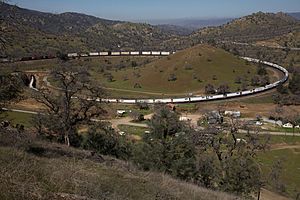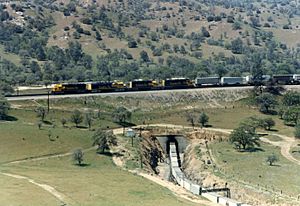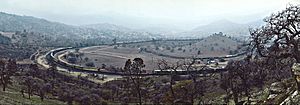Tehachapi Loop facts for kids
The Tehachapi Loop is an amazing railway track shaped like a giant spiral. It's about 3,779 feet (0.72 mi; 1.15 km) long and is part of the Union Pacific Railroad line. You can find it in the Tehachapi Mountains in Kern County, California. This special track helps trains travel between Bakersfield and the San Joaquin Valley to Mojave in the Mojave Desert.
The track goes up steadily, gaining 77 feet (23 m) in height as it makes a big circle about 1,210-foot (370 m) across. What makes it so cool is that if a train is long enough, it will actually pass over itself as it goes around the loop! At the bottom of the loop, the track goes through a tunnel called Tunnel 9.
About 36 freight trains use the Tehachapi Loop every day. It's a very popular spot for railfans, who love to watch trains. Because it's such a clever piece of engineering and a beautiful place, the Tehachapi Loop was named a National Historic Civil Engineering Landmark in 1998. It's also known as California Historical Landmark #508.
Contents
How the Tehachapi Loop Was Built
Why Was the Loop Needed?
The Tehachapi Loop was a huge engineering challenge for its time. It was built by the Southern Pacific Railroad to make it easier for trains to climb the steep Tehachapi Pass. Building a straight track up the mountain would have been too steep for trains. The loop helps the trains gain height gradually.
When Was the Loop Constructed?
Work on the loop started in 1874, and the railway line officially opened in 1876. Many people helped build it, including Arthur De Wint Foote and the main engineer, William Hood. The siding (a short track next to the main one) on the loop is called Walong. It was named after a railroad worker named W. A. Long.
Who Built This Amazing Track?
The construction of the Tehachapi line was led by Southern Pacific's engineers, James R. Strobridge and William Hood. A large number of Chinese workers did most of the hard work. They built 18 tunnels and 10 bridges along the Tehachapi line.
Between 1875 and 1876, about 3,000 Chinese workers used simple tools like picks, shovels, and horse-drawn carts. They also used blasting powder to cut through solid rock. They created the spiral-shaped loop, which is about 0.73 miles long. The track goes up about 2.2 percent, gaining 77 feet in height. Later, in 1882, the line was made longer through Southern California and the Mojave Desert. About 8,000 Chinese men worked on this part too.
Remembering Those Who Worked on the Railroad
There is a large white cross, called "The Cross at the Loop," on top of the hill in the middle of the loop. This cross is there to remember two Southern Pacific Railroad employees. They sadly died on May 12, 1989, in a train accident in San Bernardino, California.
If you want to learn more, the Tehachapi Depot Museum is in the nearby town of Tehachapi.
How Trains Use the Loop Today
Who Owns and Uses the Tracks?
The Tehachapi Loop became part of the Union Pacific Railroad in 1996. This happened when Union Pacific and Southern Pacific railroads joined together. Trains from the BNSF Railway also use the loop. They have special permission to use the tracks.
Can Passengers Ride Through the Loop?
Even though Southern Pacific used to run passenger trains on the loop, they stopped allowing them in 1971. This was when they handed over their passenger services to Amtrak. Union Pacific has kept this rule, so Amtrak's San Joaquin train cannot directly go to Los Angeles using the loop. Instead, Amtrak uses buses, called Thruway Motorcoach, to take passengers between the Central Valley and Los Angeles.
There is one exception: the Coast Starlight train. It can use the loop as a different route if its usual path, the Coast Line, is closed for some reason.
Tehachapi Loop: A California Landmark
What Does the Landmark Sign Say?
The Tehachapi Loop is recognized as California Historical Landmark #508. The sign at the landmark says:
- NO. 508 TEHACHAPI LOOP - From this spot may be seen a portion of the world-renowned Loop completed in 1876 under the direction of William Hood, Southern Pacific railroad engineer. In gaining elevation around the central hill of the Loop, a 4,000-foot train will cross 77 feet above its rear cars in the tunnel below.






